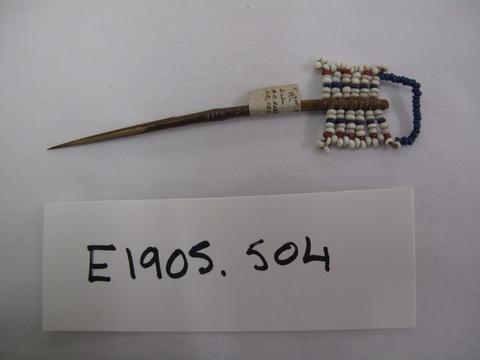Title and statement of responsibility area
Titel
Pin
Algemene aanduiding van het materiaal
- Object
- Tekst document
Parallelle titel
Overige titelinformatie
Title statements of responsibility
Titel aantekeningen
- Source of title proper: Nessa Leibhammer for FHYA using MAA materials
Beschrijvingsniveau
Stuk
archiefbewaarplaats
referentie code
Editie
Editie
Edition statement of responsibility
Class of material specific details area
Statement of scale (cartographic)
Statement of projection (cartographic)
Statement of coordinates (cartographic)
Statement of scale (architectural)
Issuing jurisdiction and denomination (philatelic)
Datering archiefvorming
Datum(s)
-
2016 - (Online curation)
-
YYYY (Making)
Fysieke beschrijving
Fysieke beschrijving
Publisher's series area
Title proper of publisher's series
Parallel titles of publisher's series
Other title information of publisher's series
Statement of responsibility relating to publisher's series
Numbering within publisher's series
Note on publisher's series
Archivistische beschrijving
Geschiedenis beheer
Bereik en inhoud
Aantekeningen
Materiële staat
Directe bron van verwerving
Ordening
Taal van het materiaal
Schrift van het materiaal
Plaats van originelen
Beschikbaarheid in andere opslagformaten
Restrictions on access
Termen voor gebruik, reproductie en publicatie.
Creative Commons License: CC BY-NC-ND
https://creativecommons.org/licenses/by-nc-nd/3.0/
Unless otherwise stated the copyright of all material on the FHYA resides with the contributing institution/custodian.
Toegangen
Associated materials
Aanvullingen
Algemene aantekening
Accession numbers
[Source - Nessa Leibhammer for FHYA using MAA materials, 2012: Cat ID: 109235; ID NO: E 1905.504; MAA num: AR.1906.801]
Algemene aantekening
Attributions and conjectures
[Source - MAA, 2012:
Names: Pin - MAA (01/12/1998)
Classified:
Keyword: Personal Adornment
Material: Wood; Bead; Glass
Descriptions: A wooden hair-pin with beaded head - MAA (01/12/1998)
Local:
Maker:
Cultural group: Zulu
Author:
Date made:
Dimensions:
Source: Haddon, A. C. (collector and donor)
Source date:
Place: Africa; Southern Africa; South Africa; Zululand - MAA (01/12/1998)
Period:
Contexts: (Centenary Exhibition). Was in EM 644 , then Box 33.D.1 June (19)87 - MAA (01/12/1998)
Object notes: This hairpin is identical to the hairpin collected by Henry Balfour on the same trip. This is securely labelled by the Pitt Rivers Museum to whom Balfour donated the item as [K-word] woman’s hair-pin, from Laduma's kraal, SWARTKOP, near P. MARITZBURG, NATAL, 1905. d.d. H. Balfour, 1906.” We can therefore assume that the two hairpins were collected at the same place or close to each other - MAA
Updated: 08/05/2014
Created: 01/12/1998]






Material contributed by members of the public
Building an archive is a collective endeavour. Please help us grow the FHYA knowledge base.
If you want to add information to this page you can insert a hyperlink, add files and/or text to the box below.
In the case of material relevant to the FHYA as a whole please upload information HERE.
The FHYA does not vet this material but reserves the right to remove anything deemed to be racist, homophobic, sexist or otherwise offensive. Everything on the FHYA is licensed under a Creative Commons CC BY-NC-ND licence.
To make a contribution you must be a registered user. To register an account, click here. Note that after registration you will not be automatically redirected to this page.
If you have already registered but are not logged in, log in here.
In 2017 the FHYA team conducted two workshops in rural KwaZulu-Natal Natal. At these workshops Grant McNulty, our facilitator, explained how Nessa Leibhamer, a researcher had been able to link two hairpins, found in two separate museums by accessing information found in the diaries of the collectors. As Nessa explains, "The Museum of Archaeology and Anthropology in Cambridge (MAA) and the Pitt Rivers Museum in Oxford have identical hairpins in their collection. The hairpin in the MAA collection was labeled ‘Zulu’ with no other information attached. However, information attached to the one at Pitt Rivers says it was collected ‘from Laduma’s Kraal, Swartkop, near P.Maritzburg, Natal, 1905. d.d. [donation date] H. Balfour 1906’. The donor of the hairpin to the Pitt Rivers Museum, Henry Balfour, and the donor of the hairpin to the MAA, A.C. Haddon, had both journeyed to South Africa in 1905 to attend a joint meeting of the British and South African Associations for the Advancement of Science. Their respective diaries have them both at Laduma’s homestead on the same day and so the evidence points strongly towards both hairpins coming from this source. Extensive historical and personal knowledge exists about Laduma, chief of the Mpumuza, who lived at Swartkops in the then Colony of Natal. With this knowledge both hairpins can be enriched with personalized knowledge about their collectors and their manufacturers and the moment of their acquisition can be contextualized at a historically specific moment in time."
At the first workshop, held at the Vukani Museum near Eshowe, Sabelo, one of the participants told us that his friend Thandi used a hairpin, which she called a hlokoloza. At the second workshop, held at the Luthuli Museum at Groutville, Boyzie, one of the participants told us very excitedly that his friend Zandile also owned a hairpin which was about 15cms long was made of metal with a head he described as being made of ‘melted plastic’. During the tea break. Boyzie he rushed off to fetch the hairpin from Zandile. On his return he explained that she had bought it from a ‘Chinese shop’ in Kwa Dukuza quite recently for about R5.00. Boyzie told us that Zandile used the Hlokoloza as a decorative hair accessory as well as to scratch her head when it itched. He also told us that, being made of metal with a sharp point, it was regarded as a very dangerous object. He and other participants then told us about people who had fallen asleep with the hairpin it in place and had injured themselves quite severely.
The workshop participants were fascinated to learn about the long history of the Hlokoloza in KwaZulu Natal and the realisation that it existed in a modern form generated a fascinating discussion on continuity and change. https://fhya.org/sfPublicUploadPlugin/file/id/235723